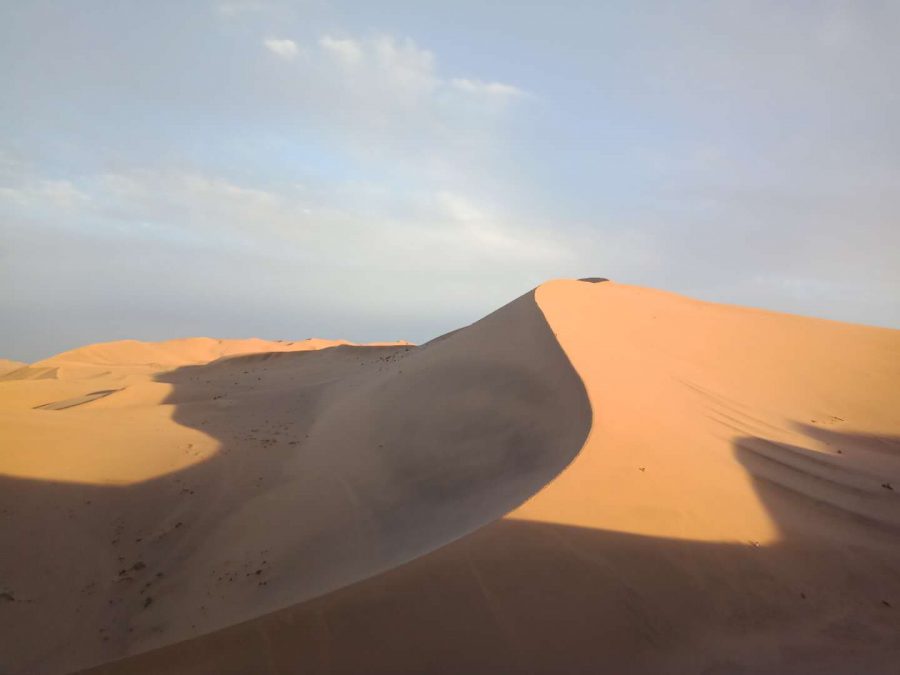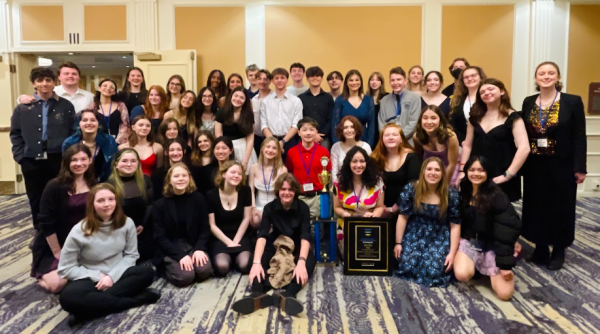What I Learned From Two Weeks in China
The Gobi Desert underlooking a pale blue sky in Inner Mongolia, China
DUNHUANG, CHINA—There is so much sand in my shoes, I’ll be able to create a desert of my own when I turn them upside down. Yet it’s better than climbing this sand dune barefoot. It hurts to run across the sand; you sink with each step, displacing the loosely packed surface, but then an inch down you come into contact with the dense sand beneath, which seems almost as hard as stone. Better to endure the constant sifting in and out of my sneakers, I suppose. Anyways, we’re almost there, almost at the top of this dune. Breathless, I fight my way to the top, taking care not to slide down and cancel out fifteen minutes’ labor.
This was the view I’d come for. In the distance, a single ridge juts up from the alien, desert landscape like the backbone of a mighty animal buried beneath the almost-lunar landscape. Behind me the setting sun pierces my eyes, casting a gentle golden-orange glow on everything that seems to soften their edges. The crescent-shaped lake this oasis sustains itself on shimmers like an enormous mirror, its ripples distorting the reflection of the sun’s fire; from this distance, the monastery built beside it seems like a child’s playkit. The sand has started to chill—it’s almost cool to the touch—but dig further down and you’ll find it’s still pleasantly warm underneath, insulated from the cold air. I could spend eternity here, I think as I settle backwards. I can tell from my classmates’ expressions that they think the same.
The 2019 theme for West Morris Regional High School District’s biennial field trip to China was the Silk Road—that vast, interconnected web of interactions and exchanges that starting from the Mediterranean Sea and ending at the Pacific Ocean. Thirty students from both West Morris Central and Mendham embarked on this adventure of a lifetime; our itinerary, planned by the travel agency Rustic Pathways, stretched from Beijing to the western edge of the Great Wall, traversing 2,000 miles of plains, mountains, and deserts, following in the footsteps of those medieval merchants and missionaries who made the painstaking journey on foot. We were a bit more fortunate, having the slight mechanical advantage of buses and airplanes.
Initially, I’ll admit, I was skeptical about this route. Conventional wisdom would suggest we visit China’s glamorous “showpiece”, the cities on its eastern shore—Hong Kong, Shenzhen, and Shanghai, the sleekest, flashiest metropolises. Instead we would trek along China’s rural west, to areas left behind by the economic boom of the last thirty years. Many of them were not as internationalized as the coastal cities. For the most part, they lacked the stamp of corporate familiarity: Starbucks and McDonalds, our beloved American staples, were missing. So were omnipresent wi-fi and Western-style toilets. This was unfamiliar territory. In a town by the name of Minqin, for example, we were the first westerners ever to visit. Would it be alien to our eyes?
On the contrary, as it happened, the further west we headed, the more familiar the landscape seemed to be. The normal people of Dunhuang, Lanzhou, and Minqin had much more in common with us than we could ever imagine. Two weeks of travel in the United States’ rising geopolitical rival taught us what could be gained through greater Sino-American cultural exchange—and what could be lost elsewise.
Officially, the journey began in Beijing, but we stayed for only one very jetlagged evening before we left again, for Xi’an, a thousand miles to the west. Xi’an holds a special significance in my heart; it is both where my family on my mother’s side hails from and China’s first and oldest capital city. Everywhere you look in Xi’an, you can see remnants of its history, melded together with its present. Thick stone walls leap up to race alongside busy streets for miles at a time before dropping off, nestling between high-rise skyscrapers and drab grey condos, wide enough to bike on (as we ended up doing, much to our delight). Buried deep in the heart of the city is a mosque built in the Ming Dynasty, still in use by the sizable local Muslim population. The main attraction of Xi’an, of course, is the Terracotta Warriors: eight thousand silent sentinels, sculpted uniquely from clay, that guard the final resting spot of Qin Shi Huangdi, the first Emperor of China.
Nonetheless, among all the old there is still plenty of new—not necessarily all good, either. Ubiquitously, constantly, like mushrooms after a storm, there appeared insidious red posters plastered on buildings, drilling the latest party slogan into the minds of the faithful. The temporary favorite at the time of our arrival was “扫黑除恶”, or literally “Sweep away the darkness and exterminate wrongdoing”, a quotation from China’s Paramount Leader Xi Jinping. As time went on, it became almost a game to us, how many of those posters we could find—the count must have been in the hundreds by the end. The long arm of the Chinese government’s propaganda ministry would follow us as we headed west, an unshakeable reminder of how different life under an authoritarian regime was compared to a democracy.
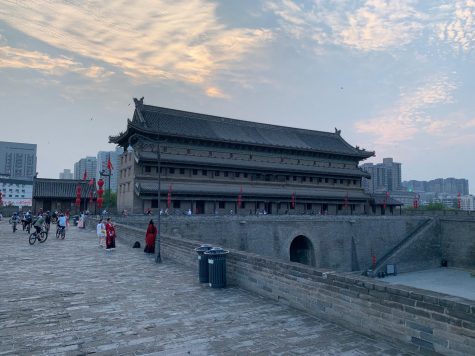
Yet still the people endure. They take everything that is thrown at them and come up with solutions, and still manage to find it within themselves to welcome strangers. After two days in Xi’an, we flew west again, this time to Dunhuang, which is situated at the western end of a narrow stretch of flat land known as the Hexi Corridor which runs between the Himalayas and the Tianshan Mountains. It is also where the Gobi Desert threatens to overrun the rest of China. Expanding at a rate of 3,600 square kilometers (1,390 square miles) a year, the Gobi Desert has unleashed dust storms on inland regions as far as Beijing.
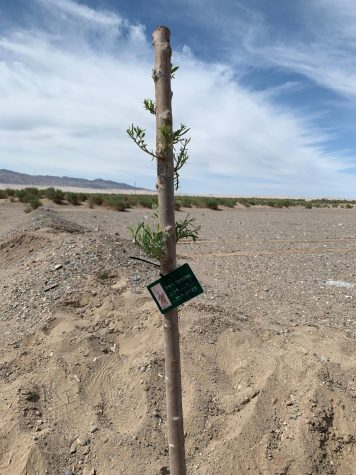
To prevent this, intrepid local businessmen have begun tree-planting businesses, planting thousands of hardy local aspen trees to man the frontlines against the encroaching sand. We too wanted to do our share to stem the tide of desertification, and so we spent our first morning in Dunhuang planting three dozen trees, neatly lined up eight meters apart, on the outskirts of the town. The owner personally came to help supervise us, and afterwards told us of some of the best locations in town to visit—one being, of course, the beautiful sand dunes above Crescent Lake. As we continued on our way, we would continue to encounter such acts of kindness from the locals, something I’m truly struck by.
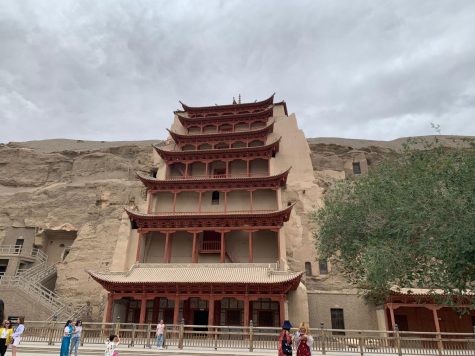
Dunhuang also boasts one of the finest surviving collections of Buddhist temples, a group of five hundred room chiseled into the mountains—the Mogao Grottoes. First carved in the 300s CE, when Buddhism was first spreading into China, the temples escaped the iconoclastic furor of the Cultural Revolution in the 1960s, and as a result are one of the best-preserved complexes in the world. Every one of the chambers was uniquely carved, then painstakingly painted, all by hand. One particularly striking room was one where every inch of the walls had been meticulously divided into tiny squares, each of which bore an icon of the Buddha painted in gold leaf. To think how many artists worked on those grottoes for how many hours, with nothing but candlelight to guide their hands, is astounding.
We began our long trek back east, heading back to Beijing, taking the same Silk Road route as those Buddhist monks had before. We passed by the lonely end of the mighty Great Wall, Jiayuguan, a square and boxy sandstone fortress. Each brick seemed laid with defiance, facing the vast open grassland beyond, where the ghosts of Mongol raiders and Xiongnu nomads still ride. Later that day we came to the Rainbow Mountains of Zhangye, where bands of sedimentary rock were disturbed by an earthquake so that they revealed their multicolor stripes to the world; there, streaks of white, red, yellow, and orange race towards the horizon, bright as the sky above.
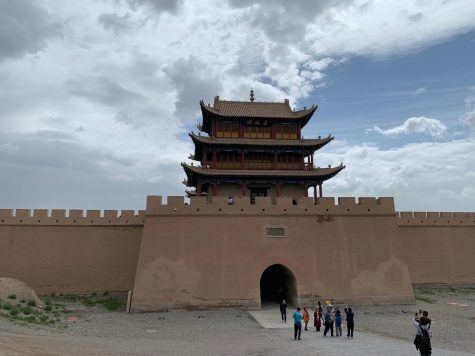
But what I regard as by far the highest point of the trip was Minqin, an isolated community on the Mongolian border, so isolated that the only westerners they had ever seen before us was our tour guide, who had come to scout out the route. I had expected curiosity; anticipated perhaps resentment. I was not prepared for the total and complete outpouring of hospitality that they gave us. The entire town seemed to turn out to welcome us. Businesses (restaurants were especially guilty of this) jostled to have us take pictures with them.
And Minqin High School mobilized when our group went to visit them at their school. The language barrier was torn down like the Berlin Wall as we interacted for three hours. We discovered they were kids just like us, struggling to balance their social lives with schoolwork, stressing over college—they have to take the devilishly difficult Gaokao, a three-day examination, to determine which university they attend. They often listened to the same music (Taylor Swift was a favorite) and watched the same movies (Avengers is just as wildly popular there as it is here). They asked such carefully thought-out questions: What do you think of the American education system, compared to ours? Do you think it is better to be well-rounded, or to specialize? And, most strikingly: what is it like to have freedom of thought?
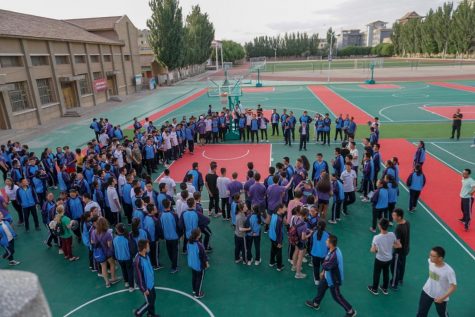
Students of West Morris Regional High School District mingle with those from Minqin High School.
I can still recall the expression on the girl’s face as she asked the question: trepidant, hesitant, yet so full of hope. It broke my heart. But by the lottery of birth, we had the fortune to live in the land of the free, home of the brave, while they—every bit the same as us—were consigned to live behind the Great Firewall and under the red shadow of the People’s Republic of China. The metaphor was completed when at the end of the three hours, after we finished hugging and waving good-bye, the school gates closed with finality, spiked to prevent any unauthorized entry or exit. We had mingled for three hours as equals, but at the end of the day we could leave. They could not.
It was truly life-changing for us American students to interact with those Chinese students. We came to the realization that the advantages and privileges we enjoy are unthinkable, almost literally, for them. At our debriefing afterwards, the counselors guided us through a discussion of the meeting. Every student had something to say, from appreciating how open-minded they were and willing to accept our viewpoints, to expressing shock at their nightmare homework routine, to noticing that there was virtually no bullying or even social ostracization at their school.
The remaining few days of the trip had a haze of melancholy over it, both from having to say good-bye to Minqin and because of the realization that the trip itself was almost over. By this time, our little band of thirty had gotten very attached to one another. Being alone in a foreign country for two weeks, no matter how inviting or hospitable, will have that effect. We walked beneath a canopy of willow trees at Lanzhou, beside the lazy waters of the Yellow River; then we toured a museum containing the fossils of a prehistoric wooly mammoth and a Han-era bronze sculpture, but our hearts and minds were largely concerned with making the last few days together count. Finally, we returned to Beijing, where we had started. We ended up at the same hotel that we started at, and the difference in atmosphere was astounding. Whereas that first day had seen a clear divide (segregation, almost) between Central and Mendham students, by the last day we were thoroughly mixed together.
As the finishing touch to cap it all off, we headed off to that most iconic of wonders, the Great Wall of China. Beneath a parched blue sky, we climbed the mighty coils of the Great Wall as it snaked around verdant green hills and forests. The winding stairs and turrets, just like they had at Jiayuguan, bore an unmistakably sad feeling, as though the thousands who had perished in its construction still haunted its stones. They evoked the magnificent coiled muscles of a caged animal—noble, powerful, yet immutably tragic. The view from the towers was achingly beautiful, with green stretching as far as the eye could see, a welcome sight after nearly two weeks of desert. Again, I felt a desire to never come down, but all good things must come to an end. We made it back to the United States just in time for the 4th of July.
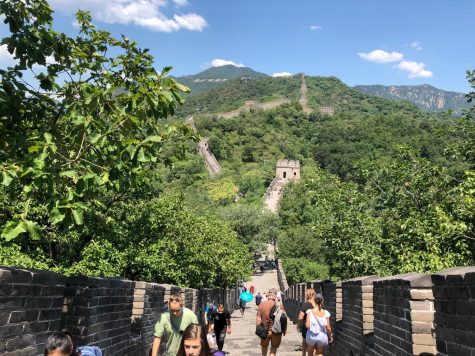
Two weeks in China taught me an incredible amount in a short span of time. It challenged my belief that America and China would always be at loggerheads. This trip has opened my eyes to the realization that the interests of Americans and the interests of Chinese are fundamentally aligned; we all want a safe planet to live on, free from the scourge of climate change and desertification, and we all want to maintain or achieve the right to free thought and free speech. At the same time, it has deepened my concerns about what we will lose if we do not seek cooperation. We have so much to gain from cross-cultural exchanges and understanding, in the spirit of the Silk Road of old, when ideas peacefully spread from one end of the world to the next. Let us not forsake it, and abandon our peace to the sands of time.
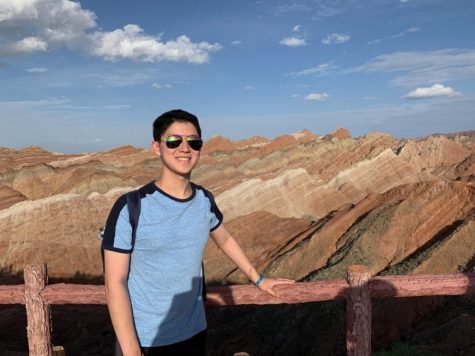
Vincent Jiang is currently a senior at West Morris Central High School and President of Journalism Club. Passionate about global affairs, he enjoys writing...

